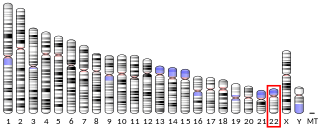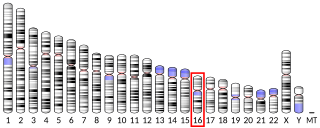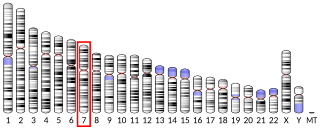
Vacuolar-type ATPase (V-ATPase) is a highly conserved evolutionarily ancient enzyme with remarkably diverse functions in eukaryotic organisms. V-ATPases acidify a wide array of intracellular organelles and pumps protons across the plasma membranes of numerous cell types. V-ATPases couple the energy of ATP hydrolysis to proton transport across intracellular and plasma membranes of eukaryotic cells. It is generally seen as the polar opposite of ATP synthase because ATP synthase is a proton channel that uses the energy from a proton gradient to produce ATP. V-ATPase however, is a proton pump that uses the energy from ATP hydrolysis to produce a proton gradient.

V-type proton ATPase subunit B, kidney isoform is an enzyme that in humans is encoded by the ATP6V1B1 gene.

V-type proton ATPase subunit E 1 is an enzyme that in humans is encoded by the ATP6V1E1 gene.

The TCIRG1 gene encodes for the V-type proton ATPase (V-ATPase) 116 kDa subunit a isoform 3 enzyme.

V-type proton ATPase 16 kDa proteolipid subunit is an enzyme that in humans is encoded by the ATP6V0C gene.

V-type proton ATPase subunit B, brain isoform is an enzyme that in humans is encoded by the ATP6V1B2 gene.

V-type proton ATPase 116 kDa subunit a isoform 4 is an enzyme that in humans is encoded by the ATP6V0A4 gene.

V-type proton ATPase subunit C 1 is an enzyme that in humans is encoded by the ATP6V1C1 gene.

V-type proton ATPase 116 kDa subunit a isoform 1 is an enzyme that in humans is encoded by the ATP6V0A1 gene.

V-type proton ATPase catalytic subunit A is an enzyme that in humans is encoded by the ATP6V1A gene.

V-type proton ATPase subunit d 1 is an enzyme that in humans is encoded by the ATP6V0D1 gene.

V-type proton ATPase subunit G 2 is an enzyme that in humans is encoded by the ATP6V1G2 gene.

V-type proton ATPase subunit G 1 is an enzyme that in humans is encoded by the ATP6V1G1 gene.

V-type proton ATPase subunit D is an enzyme that in humans is encoded by the ATP6V1D gene.

V-type proton ATPase subunit F is an enzyme that in humans is encoded by the ATP6V1F gene.

V-type proton ATPase subunit G 3 is an enzyme that in humans is encoded by the ATP6V1G3 gene.

V-type proton ATPase 21 kDa proteolipid subunit is an enzyme that in humans is encoded by the ATP6V0B gene.

V-type proton ATPase subunit e 1 is an enzyme that in humans is encoded by the ATP6V0E1 gene.

V-type proton ATPase 116 kDa subunit a isoform 2 also known as V-ATPase 116 kDa isoform a2 is an enzyme that in humans is encoded by the ATP6V0A2 gene.

V-type proton ATPase subunit E 2 is an enzyme that in humans is encoded by the ATP6V1E2 gene.



















